
Tesla Model S Review, Range & Pricing

Introduction
Strictly speaking, the Model S is sold as an all-electric saloon car, but you wouldn’t know it.
With a low ride height, a coupe-like sweeping roofline resembling a Jaguar XK from some angles, and a boot that opens just like a hatchback, it looks more like a sports car – and goes like one, too.
But instead of a roaring V8, it’s whisper quiet. It is a Tesla, so it’s all-electric. Trips to the petrol station are no more, as are carbon emissions, while the massive touchscreen inside is like mission control.
Select's rating score* - 4.1 / 5
At a Glance
The front looks aggressive without even trying very hard. It is minimalist but not tame. Angled headlights create an angry frown with jagged air intakes on either side of a lower grille, leaving a thin strip of bodywork underneath acting as a splitter.
With no combustion engine, there’s no main grille, so the space is occupied by a Tesla badge and some chrome styling, which is a worthwhile substitute. As a result, the front doesn’t look bare, but it seems a bit odd at first, although you’ll quickly get used to it.
It is only from a 45-degree angle that it seems a bit peculiar, as the boot looks like it’s not there, which makes the car’s proportions seem strange.

Side on, the executive car shape is more noticeable. But so is the lower ride height, the angled crease towards the bottom, the side fenders (which are really cameras) and the rear windows sweeping upwards. What’s more, you’ll notice that the Tesla has enormous wheels.
At the back, it looks slightly more modest. You get a chrome strip running along the width of the boot lid, cutting into the indicators, and, on our test model, there's a spoiler glued to the rear.
Key Features
The numbered variants of the Model S (such as the top-of-the-range P100D) are no more. Instead, the line-up is now simplified into two models, depending on how many electric motors you want.
The standard Model S is a dual-motor, producing 670PS, with a top speed of 155mph and a standstill to 60mph time of 3.1-seconds.
But if that’s too slow for you, there’s the Model S Plaid version, which is a tri-motor. It has a top speed of 200mph and goes from nought to 60mph in a staggering 1.99-seconds. Oh, and it’s 1020PS. And that’s “ludicrous” (as you’ll see later).
The Model S is expensive to begin with. But it wouldn’t be a Tesla without costly add-ons that enhance some of the best technology you can get. But stay patient - we’ll cover those later.
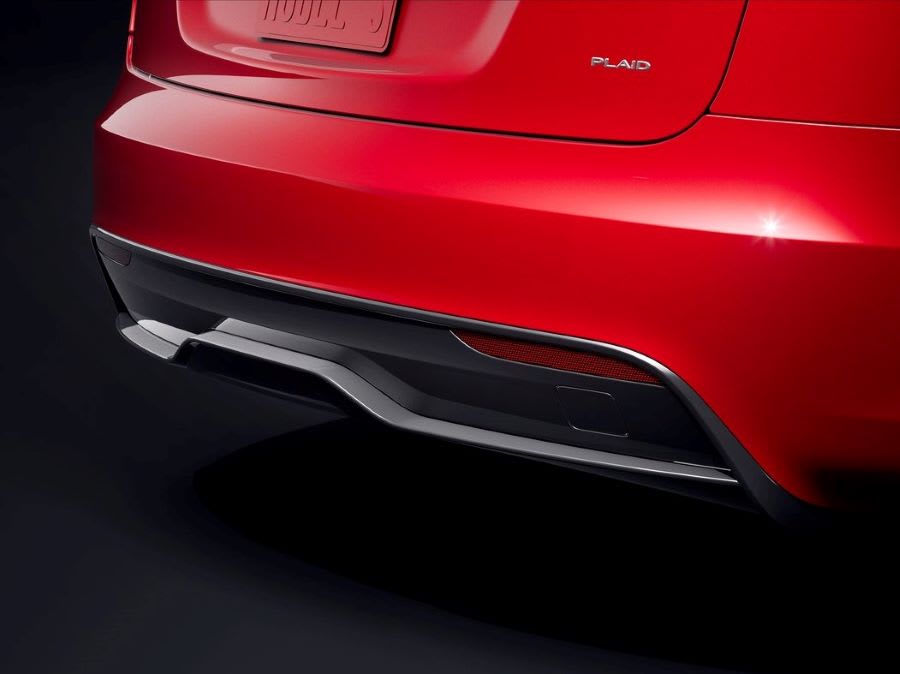
As standard, you get 19-inch wheels and a 17-inch central infotainment display with navigation. The car also houses internet access, games and video streaming apps, and a 12.3-inch digital instrument display. You also get an eight-inch screen in the rear, heated seats and steering wheel, a 22-speaker premium audio system and ventilated front seats. Plus, Tesla provides three-zone air conditioning, a tinted glass roof, an automatic tailgate, power-folding door mirrors, wireless charging, and flush pop-out door handles.
You get a 12-month subscription to access the internet-based services, too.
Both variants come with four-wheel drive. However, the Plaid has subtle tweaks to its exterior, such as that spoiler we mentioned and some black styling, notably on the wheels.
The Model S was also, until recently, the most aerodynamically efficient production car in existence (the Mercedes-Benz EQS has since surpassed it, though).
If you're clued up about Tesla and were wondering, a third model called the Plaid+, which was going to extend the Plaid’s range by about 125 miles, was cancelled last year.
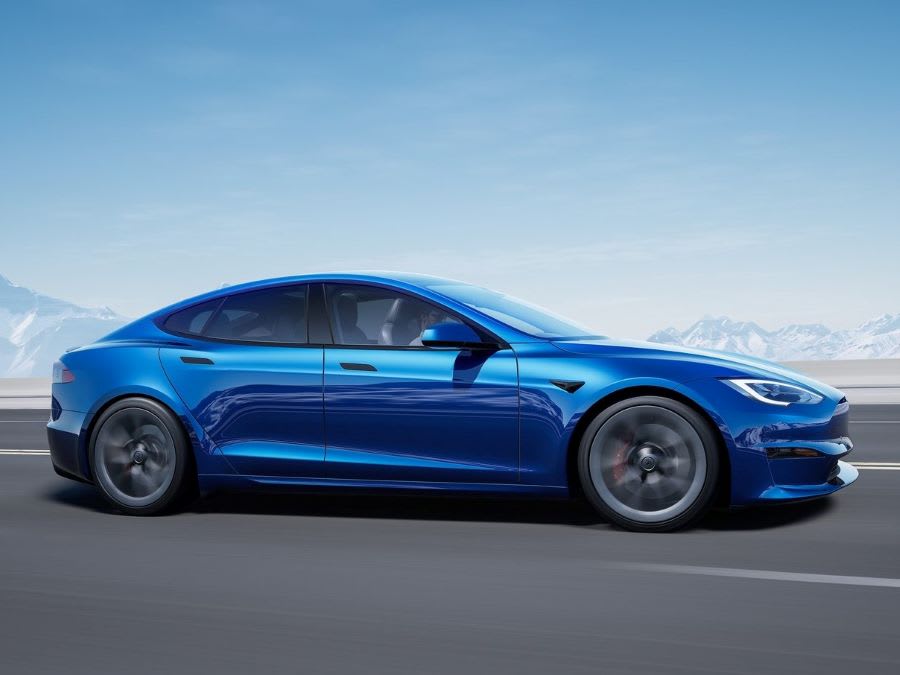
Range & Batteries
Despite the vast population of horses under the bonnet, the power doesn't limit range much.
The standard Model S, itself ridiculously performance-driven, can manage 405 miles. But the Plaid version, with its blistering zero to 60 time, only reduces this to 396-miles while powering an extra motor.
These figures will reduce if you opt for bigger wheels. However, many factors, including temperature, driving style and weather and road conditions, have an impact, too.
Everything about Tesla screams minimalism, from the buttonless, switchless interior to the company's website. As a result, Tesla doesn't complicate things by talking about battery sizes, kWh and the like. Instead, it simply tells you range, zero to 60mph times and top speed - and it assumes that’ll be enough to convince most.
Nevertheless, the batteries are 100kW in both versions, in case you wanted to know, and while Tesla make it easy to work out, we've got a guide ready to explain what kWh and kW really means.
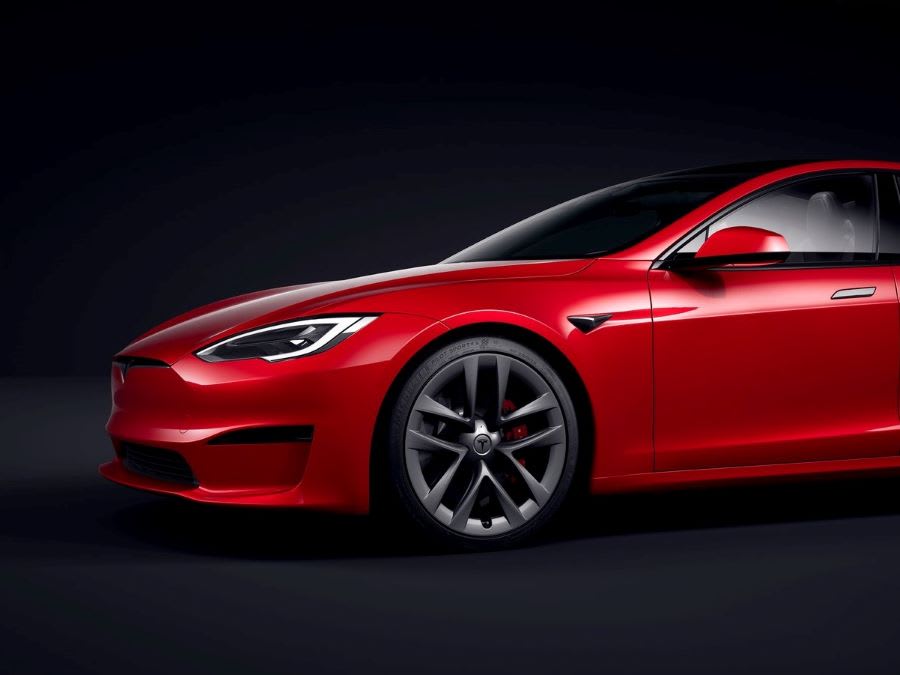
Performance & Drive
If minimalism is at the heart of the Model S, you know about it from the moment you step inside.
There are no keys to be turned or clutch pedals to be pressed. There isn’t even a ‘Start’ button. It automatically knows you’re in the car, so it switches on. Of course, there’s no engine to start up, so you press the brake pedal, select 'Drive', move your foot onto the accelerator and away you go.
Around town, the ‘yoke’ steering wheel (which we’ll describe later) is an inconvenience. Maybe you’ll get used to it, but we found ourselves constantly trying to grab on to bits of it that weren’t there when turning a corner. The only feasible way to drive is to keep your hands in the same position on the wheel and cross your arms when turning (which rules it out of being used for your driving test).
One-pedal driving is typical in the Tesla. You stick your foot on the accelerator to speed up and lift off to brake, which then converts the heat generated under braking to put it back into the batteries.

The seats soak up bumps at higher speeds on the motorway, and the suspension is also absorbing. As a result, the Model S is relaxing to drive, and the autonomous systems make it effortless without letting you take your focus off the road. In addition, the adaptive air suspension adjusts the ride height at pace to maximise aerodynamic efficiency, saving energy consumption.
Selecting Sport mode firms up the suspension, which limits body roll in the bends, albeit sacrificing a bit of ride comfort in the process. The steering isn’t as precise as German rivals, but it handles well and makes for a lot of fun. What’s more, the large wheels and four-wheel drive provide a tremendous amount of grip. As a result, the acceleration when exiting corners is ferocious.
Road noise isn’t too bad, either, thanks to noise-cancelling technology in the cabin, which comes via the speaker system.
No matter what speed you’re driving at, you can outperform just about anything on the road at any time. We would call the performance ‘Ludicrous’ because that’s exactly what Tesla calls it. Literally. If you engage Ludicrous mode, you get to 60mph in 2.4 seconds. But now it’s been replaced by Plaid and Plaid+ mode, which gets you to 60 in that magical hundredth of a second under two.

There is even something called 'Drag Strip Mode', which takes five minutes to enable, as the car has to condition the batteries. Then you roar off with a smooth, effortless but mind-blowing level of acceleration.
We were also lucky enough to be able to go to an airstrip and test the Plaid at 200mph – and we’re glad we did so you don’t have to. Of course, most people will never be in a position to attempt such speeds, but we wouldn't recommend it even if you could.
The Model S isn't designed for such performance, even if its electric motors disagree. Approaching about 150mph, it was wallowing about. The steering is too sensitive to cope with such speeds, and it's a battle to keep it in a straight line.
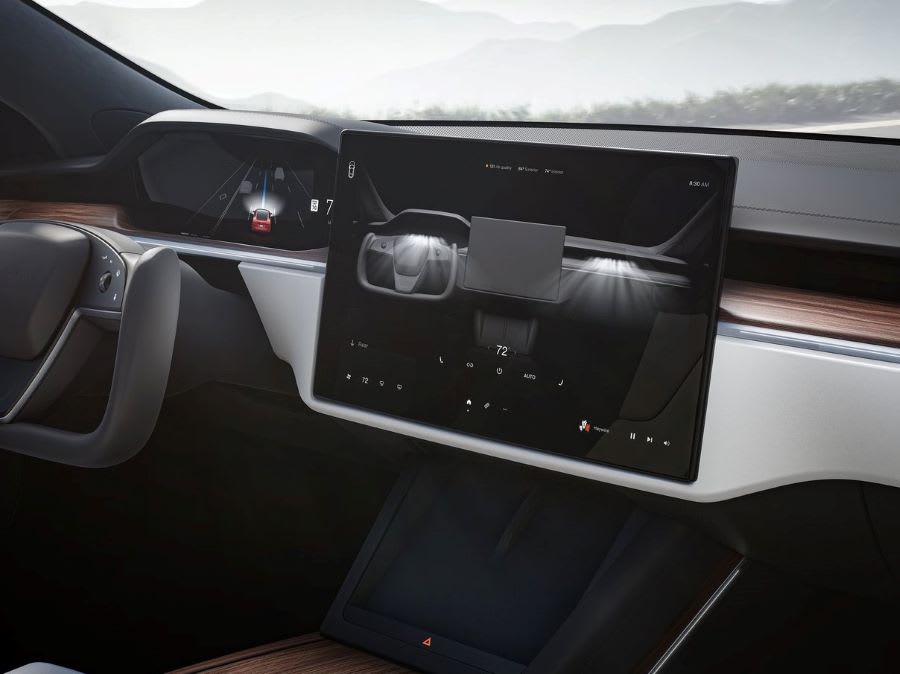
Charging
One of the top things about leasing a Tesla is that you get access to its network of ‘Supercharger’ points.
Charging at 75kW will get you from 0-80 per cent in just over an hour. Or, if using a 120kW unit, it’ll achieve the same in under 45 minutes, which will definitely come in handy for those who can't charge at home.
A home wall-box will take a more modest 14 hours, however, so be sure to pick your ideal charger to help reduce your time spent waiting to drive.

Running Costs & Emissions
Depending on your electricity tariffs, a full charge at home will cost you in the region of £15 to £20. Therefore, the savings compared with filling up a fuel tank are apparent, even if energy prices are shooting up.
If you’re using the Model S as a company car, it’s in the lowest Benefit-in-kind (BIK) tax bracket. Plus, it’s exempt from most clean air zone and congestion charge fees thanks to its zero emissions.
Just for your information, Tesla offers a four-year servicing plan, while the Model S gets a four-year warranty. But you don't need to worry about this too much when you lease.
Interior & Technology
You won’t notice the interior when you first step inside and sit in the driver’s seat. Not because the minimalistic styling means there’s nothing to look at, but because you’ll be fixated on the fact that Tesla has literally reinvented the wheel.
It is more of a ‘yoke’ that looks like it's been taken straight out of an aircraft. It is amazingly cool to look at, and because there's no 'top' to the wheel (it's 'u'-shaped), you get an unobstructed view of the digital instrument display. We suspect replacing something as fundamental as the steering wheel will be a step too far for some.
The yoke wheel features touch-sensitive buttons. These switches operate the indicators, main beam, horn, windscreen washers and voice control, but they’re too easy to activate accidentally.
The massive landscape screen embedded into the dashboard has now been replaced with a portrait tablet that sits on the dash. It is very responsive, and everything in the car is controlled through it (including a web browser and games).
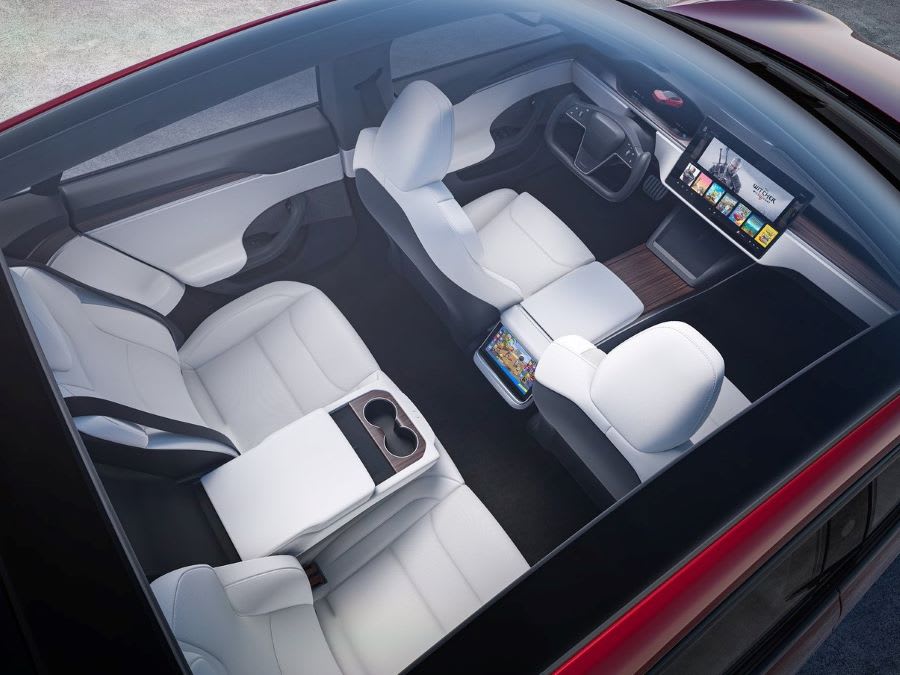
You can swipe your finger along the screen to put the car into Park, Neutral, Drive and Reverse. There are also touch-sensitive buttons lower down the dashboard that do the same.
One of the initial criticisms of Tesla was that the interior quality wasn’t up to scratch, even if it did look nice. Many improvements have now been made in this area, although the build quality is not on the level of, say, Mercedes-Benz, BMW, or Audi.
The sports seats are comfy, and the materials feel a step up from what Tesla used to offer. It is all well-designed, sleek, and sophisticated.
There is also a screen in the rear that can adjust airflow, and you can even use apps to watch YouTube, Netflix, and the like.

Practicality & Boot Space
There is a considerable amount of storage in the central cubby, with numerous sliders that open to reveal more space, as well as a retractable cupholder. The glovebox is on the small size, however.
Thanks to the front seats not being bulky, there’s a decent amount of rear legroom. But you can’t get your feet underneath the front seats, which means that finding a relaxing position for longer journeys is difficult. The back chairs are low to the floor, too, which makes it worse as you’ll end up with your knees approaching chin level if you’re over six feet tall. At least that means headroom isn’t an issue, though.
Despite the Model S’s sports car styling, you’ll be able to fit three adults in the back, and the middle seat is comfortable – so taking three kids won’t be an issue.
If the middle seat is unoccupied, it can be folded down, revealing more storage space, two wireless phone charging pads, and two cupholders.

Another thing you’ll notice is that the glass roof isn’t sunroof-sized – it covers virtually the entire ceiling of the car.
Around the back, there are 804-litres of boot space or, if you fold down the rear seats, this expands to 1,645-litres.
Annoyingly, although you push a couple of buttons to release the seats electrically, this doesn't make them fold down. Instead, you need to lean into the boot to push them down, which is frustrating, given that Tesla is all about clever technology.
The lack of a combustion engine means there's a boot in the front, too, which provides about 150-litres of additional storage.
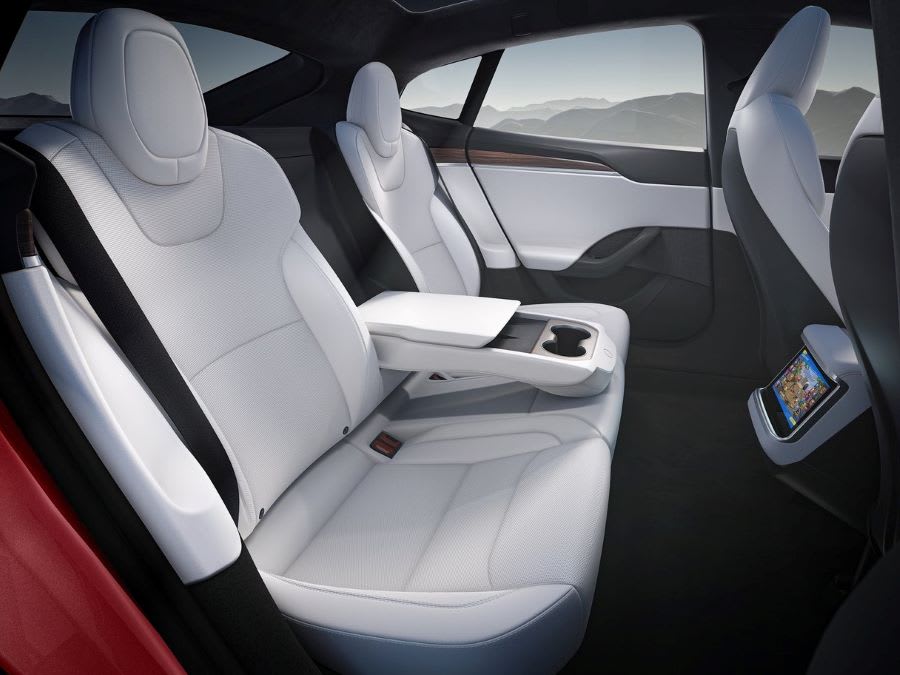
Safety
The Model S netted a maximum of five stars for safety, scoring 82 per cent for adults, 77 per cent for children but only 71 per cent for safety assists when tested by Euro NCAP.
This may be because much of its safety assists are provided through the Autopilot functionality, which is an optional extra.
In addition, this rating is eight years old. So, given the evaluating criteria has changed, it may be that the autonomous features bump this up as they have been added to and improved over the years. Mind you; Euro NCAP has also made some of its scoring more stringent.
At least you can be confident that this Tesla has all the tools you need to keep you safe – especially if you pay for them.

Options
The magic of Teslas, of course, is that they have some of the most advanced autonomous driving features on any car. The problem is, they’re optional extras.
You can add on 'Enhanced Autopilot', which means it can drive and steer itself on motorways. It can change lanes to overtake, slow down and speed up as required by itself, too. The car can also detect parking spaces and then park itself.
Furthermore, you get 'Smart Summon', meaning you can press a button, and the Tesla will drive itself to you. This feature is perfect for when it’s raining, and you've had to park at the far end of the car park and have a trolley load of shopping to carry.
But wait, there’s more! Full Self-Driving Capability adds all the above, plus the full self-driving computer, which will give you more autonomous driving capability. This is also being constantly developed with over-the-air software updates. Eventually, Tesla will aim to push a button that will give your car the ability to drive itself fully. And it’ll all come via a software update which it will install itself.
There are five exterior colours – white, dark grey, blue, red and black. Only white is free. The others are a four-figure extra sum.
Tesla also provides three interior colours – black, white, and cream. White and cream interiors get you walnut décor inside and ebony if you choose black.
If the 19-inch wheels aren’t big enough for you, you can upgrade to 21-inches (if you don’t mind spending a few grand more).

Rival Cars
Alternatives include the Porsche Taycan and the Audi e-tron GT, both of which are all-electric sports cars (both have cheaper entry-level models than the Model S, too). There is also the new Mercedes EQS luxury saloon.
If you want more practicality, you should look at SUVs like the Audi e-tron (not to be confused with the e-tron GT),Jaguar’s I-Pace or the Mercedes-Benz EQC.
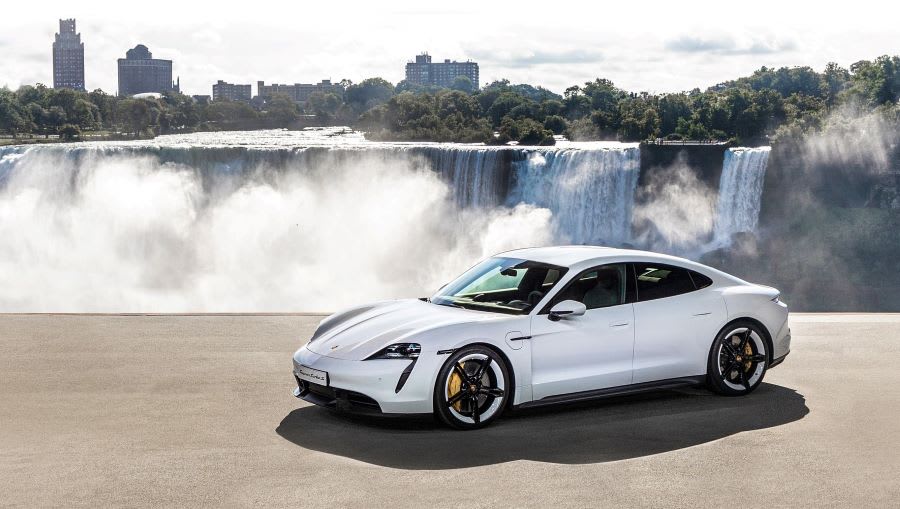
Verdict & Next Steps
The Tesla Model S is a genuinely great car.
There is nothing quite like it. The vehicle is staggeringly quick, quiet and the improved cabin is full of technological gadgetry. That said, we wonder how much longer Tesla can avoid associating itself with Apple CarPlay or Android Auto.
It handles well, although it's not quite as polished as German rivals, and there are still concerns about its build quality.
That is not what you want to hear for a car that’s so expensive (even more so if you add the Autopilot extras and bigger wheels).
We can’t help but love it, though. Like Tesla’s founder, the Model S has the ‘wow-factor’ and a fascinating hint of eccentricity.
Where to next?
View latest Tesla Model S Leasing Deals today!
Looking for a great leasing deal? Check out our incredible range of Special Offers
New luxury electric car? Read our latest Car Reviews and find the right model for you
Want to know more about leasing? Take a look at our comprehensive Leasing Guides
Interested in everything motoring? Why not catch up on all the latest Car Leasing News.
*Score based on Select’s unique meta score analysis, taking into account the UK’s top five leading independent car website reviews of the Tesla Model S





















